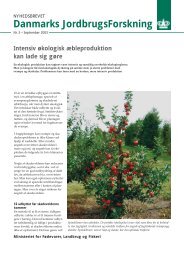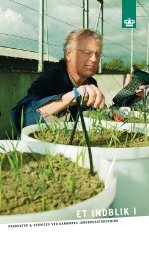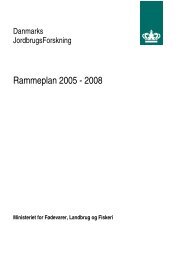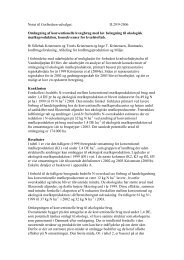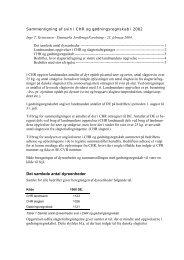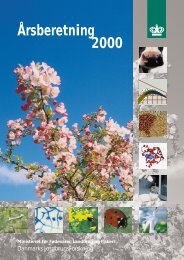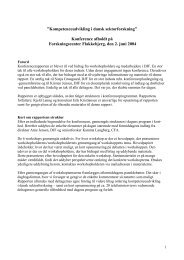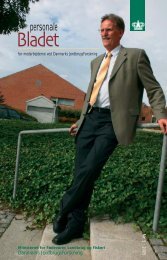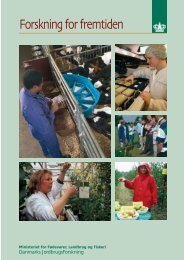Reproduction performances and conditions of group-housed non ...
Reproduction performances and conditions of group-housed non ...
Reproduction performances and conditions of group-housed non ...
Create successful ePaper yourself
Turn your PDF publications into a flip-book with our unique Google optimized e-Paper software.
- Paper III -<br />
2.2.4 Aggressive interactions, skin lesions <strong>and</strong> lying solitary<br />
Involvements in aggressive interactions (Barnett et al., 1981; Mendl et al., 1992), skin le-<br />
sions (Barnett et al., 1992) <strong>and</strong> frequency <strong>of</strong> lying solitary during resting periods (Barnett et<br />
al., 1984; Bonde, 2004) were used as indicators <strong>of</strong> stress. For a discussion <strong>of</strong> why these<br />
parameters are believed to be suitable indicators for stress, see review by Kongsted (2004a).<br />
The first hour after weaning <strong>and</strong> half an hour at mating <strong>and</strong> three weeks after mating outside<br />
the resting period, the number <strong>of</strong> aggressive interactions the individual sow participated<br />
in was recorded. An interaction was defined to have occurred when one sow initiated<br />
a behaviour, which was clearly directed at another sow in the <strong>group</strong> (Bradshaw et al.,<br />
2000). All interactions were categorised into four different types: 1) a threat, 2) one<br />
bite/knock/push, 3) several bites/knocks/pushes <strong>and</strong> 4) bites from both sows (Jensen et al.,<br />
1996; Bradshaw et al., 2000; Jensen et al., 2002).<br />
The total number <strong>of</strong> skin lesions divided into four length categories (10<br />
cm) on head, ears, neck <strong>and</strong> shoulders (Barnett et al., 1992) were recorded for all F-sows by<br />
a research technician. All lesions (except shoulder wounds because they are not a result <strong>of</strong><br />
aggressive interactions) were recorded (also superficial scratches). The recordings were<br />
performed in the home pen <strong>of</strong> the F-sows, i.e. in a <strong>group</strong> <strong>of</strong> sows. Total length was calculated<br />
as total number in the length category 1-4 multiplied with 0.5, 2.5, 7.5 <strong>and</strong> 10 respectively.<br />
The behaviour <strong>of</strong> the F-sows was recorded during resting period for 25 minutes. Every five<br />
minute the position <strong>of</strong> the individual sow (in a feeding stall, in the dung area, in the resting/activity<br />
area) was recorded <strong>and</strong> the ten F-sows’ behaviour were categorised into the<br />
following: 1) lying/sitting solitary, 2) lying/sitting socially or 3) st<strong>and</strong>ing/walking/running<br />
(if a sows position was a feeding stall her behaviour was not recorded). Lying/sitting solitary<br />
was defined as lying/sitting in a distance <strong>of</strong> 20 cm or more from other sows (Bonde,<br />
2004). If the sow was lying/sitting more frequently than not, the sow was categorised as<br />
lying. If the sow was lying/sitting solitary more frequently than lying/sitting socially, the<br />
sow were categorised as lying solitary.<br />
2.3 Timing <strong>and</strong> frequency <strong>of</strong> recordings<br />
The timing <strong>of</strong> registrations were first <strong>of</strong> all chosen to give information <strong>of</strong> the sows’ <strong>conditions</strong><br />
from weaning to first mating <strong>and</strong> from first mating to three weeks in pregnancy because<br />
these phases seems to be the main periods <strong>of</strong> relevance regarding reproduction performance<br />
(Kongsted, 2004ab). The timing <strong>of</strong> the above mentioned recordings <strong>and</strong> measurements<br />
are presented in Table 2. The recordings took place at weaning, at mating, ap-<br />
66




